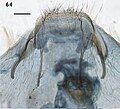Ectoedemia phaeolepis: Brief Summary
provided by wikipedia EN
Ectoedemia phaeolepis is a moth of the family Nepticulidae. It is endemic to the Iberian Peninsula.
The wingspan is 5.4–6 mm. Adults are on wing from late May to early August.
The larvae feed on Quercus ilex and Quercus rotundifolia. They mine the leaves of their host plant. The mine consists of a narrow sinuous gallery which changes later into a large blotch with two lateral bands of frass.

Male genitalia

Male genitalia

Female genitalia

Female genitalia

Female terminal abdominal segment

Leafmine
- license
- cc-by-sa-3.0
- copyright
- Wikipedia authors and editors
Description
provided by Zookeys
Description. Male (Figs 41, 42). Forewing length 2.4–2.8 mm, wingspan 5.4–6.0 mm. Head: frontal tuft dark ochreous, with several brownish scales, collar ochreous; scape yellowish white; antenna dark brown-black, with 39–41 segments. Thorax nearly black with several brownish scales in its hindpart. Forewing covered with dense black scales, the light ground coloration partly visible only near apex; fascia nearly white, with a sharp basal and more blurred distal edge; cilia-line more or less distinct; cilia ochreous grey; underside brown-grey. Hindwing and cilia grey, distinct field of black androconial scales in its basal half, it reachs up to the hind margin of the wing, hair pencil fuscous; underside grey. Abdomen brownish black. Legs ochreous grey.
Female. Forewing length 2.5–2.7 mm, wingspan 5.5–6.0 mm. Antenna with 28–31 segments. The coloration as in male, hindwing without androconial scales.
Male genitalia (Figs 47, 52). Capsule length 225–260 μm. Vinculum distinctly concave anteriorly. Tegumen broad, rounded, without distinct processes or lobes caudally, with several long setae. Gnathos broad, lateral processes broad and rounded caudally, distinctly shorter than central element. Valva length 180–210 μm, broad, continuously narrowed caudally, with acute distal process, sublateral processes shorter than ¼ transtilla length. Aedeagus 325–350 μm long, with distinct cathrema, with many very small cornuti in vesica, carinae simple, pointed.
Female genitalia (Figs 56, 60, 64). T8 with ca 17–19 setae on either side; T8 with rounded corners, and posteriorly straight. Papillae anales broadly rounded, with about 10–14 short setae each. Apophyses short and thick. Vestibulum with distinct vaginal sclerite and a “spiculate” pouch without spines. Corpus bursae ca. 610 μm long, almost globular, covered with minute pectinations; signa almost similar, ca 325–390 μm long (n=2), approximately 1.9–2.5 as long as wide, ca 10 cells in width. Ductus spermathecae with about 4.5 sclerotized convolutions.
- bibliographic citation
- Van Nieukerken EJ, Laštůvka A, Laštůvka Z (2010) Western Palaearctic Ectoedemia (Zimmermannia) Hering and Ectoedemia Busck s. str. (Lepidoptera: Nepticulidae): five new species and new data on distribution, hostplants and recognition.
Distribution
provided by Zookeys
Distribution. Iberian Peninsula: Portugal and Spain.






